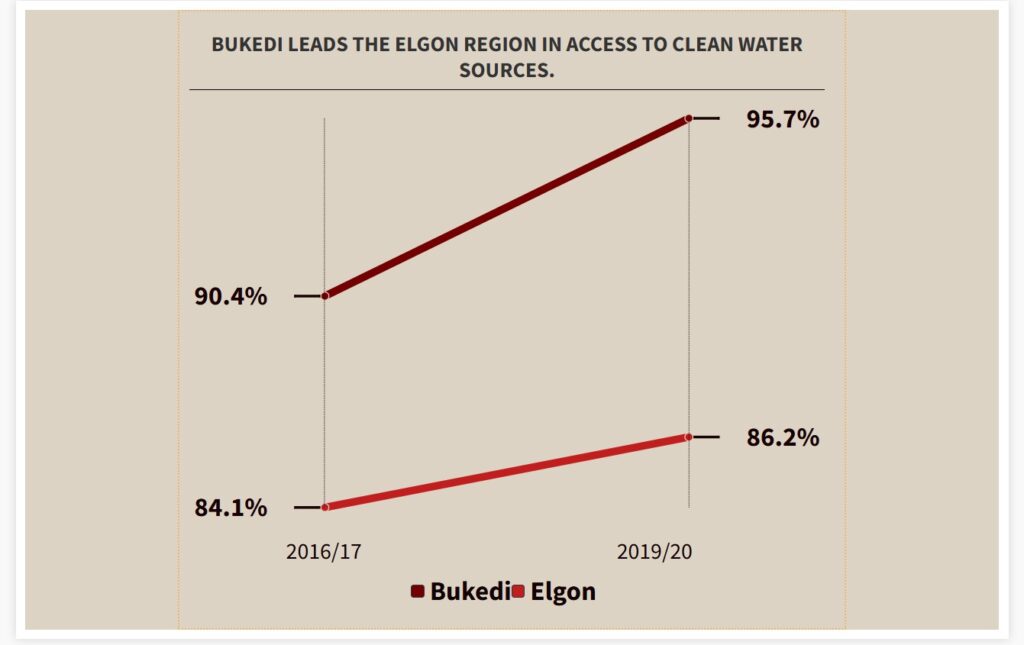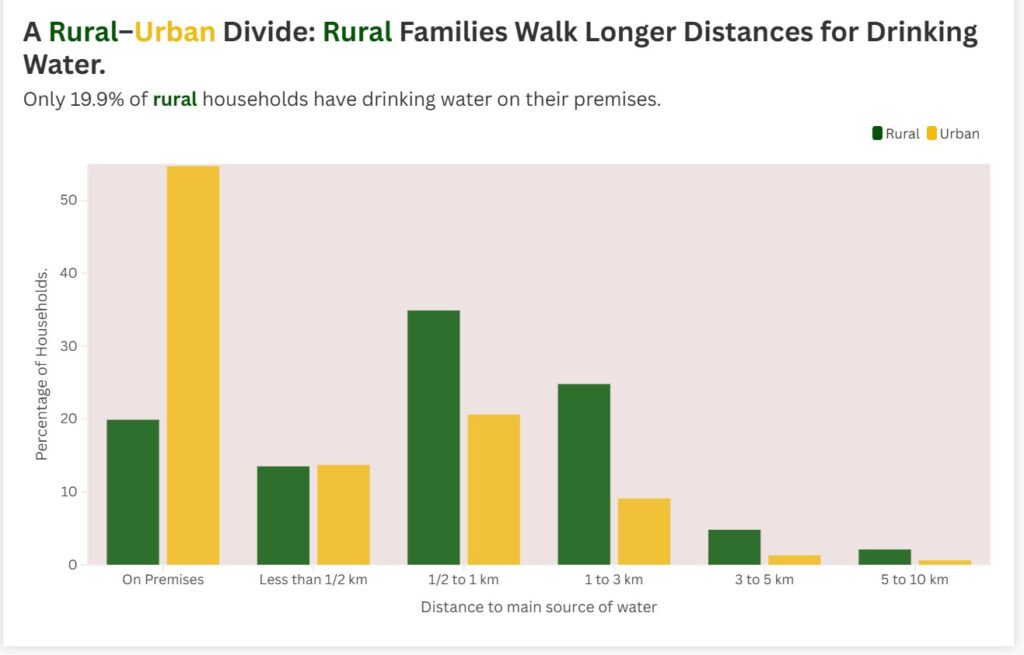Deciding Jointly:
Communities Team Up With NGOs to fix Water Crisis
Written by: Hellen Kabaukya.
Written by: Hellen Kabaukya.
A 20-liter jerrycan of water in Buteeba, a community outside Uganda’s eastern border town of Busia costs shillings 1000, way above the normal Shillings 200 in the parts of the region and the country.
Aside from the exaggerated price, one has to walk for over a kilometer, and cross the border to the Kenyan side to fetch it.
“If you cannot afford the money, you have to deal with long queues at Boreholes and wells that serve both animals and people” explains Elizabeth Okose, the Incharge of Buteeba Health center whose patients, including pregnant mothers struggle to get water to clean up while at the facility.
Buteeba houses over 20,000 people. On average, each of these people need about 10 liters of water to sustain the activities of the day at the facility.
Hygiene issues are prompting many residents to shy away from the facility. Many mothers are choosing to give birth at home, with the assistance of traditional birth attendants (TBAs), or travel to Busia as an alternative, further complicating their situation.
Hundreds of kilometers away is Buhehe, a community in Mbale district with the same challenge. At the community Health Center, patients, hospital staff have to endure long queues for water together with the residents as it’s the only nearest source of clean water in the village.
“We get many doctors leaving the hospital because they have no water. Imagine you are a doctor taking two days without bathing and you’re treating people.” Incharge of Buhehe Hospital who preferred anonymity in this story
Access to clean water in eastern Uganda is significantly limited. Only 9% people in the region have the privilege of clean piped water according to a study by public service tracker Twaweza.
Many people travel long distances to collect water from potentially contaminated sources like swamps; this often disproportionately affects women and girls due to the time spent fetching water.

When it comes to WASH facilities in the region, little can be said about the state in which they operate. The value of adequate WASH facilities in schools and hospitals cannot be overstated.
This is the plight of the greater Eastern region.
Located at the tail end of the low lying plains of Mbale, near the rear-end of the iconic Wanare Hill, lies St Joseph’s Primary school Musooto.
A jerrycan supported by two sticks hangs in the compound. It’s a reminiscence of the purpose it served before the school got better hand washing stands.
Not so long ago, this manually refillable 5ltr jerrycan was serving as the washing point for over 1000 learners at this school.
The water and sanitation facilities in the school barely reached the minimum stands with pupils having to wait in line for their turn to use the latrines and zero place for them to access safe Drinking water.
“We only had four stances for girls, and they are 1,260. Now that number versus four stances, it was a problem”’ Washak Stephen Headteacher St Joseph Primary School Musoto
The story remains the same for many of the schools in the region.
It’s a Systemic Challenge.
Access to an improved water source is a prerequisite for improved health. Additionally boreholes and other point water sources are designed to serve 100 to 300. According to the National Population and Housing Census 2014 the distribution of main sources of drinking water by households were: Piped water (20.7%), Boreholes (33.5%), Protected springs/ wells (16.6%), and unimproved sources e.g. lakes, rivers, streams, ponds (28.8%).
This implies that 28.8% (9.96 million Ugandans) are at risk of contracting water borne diseases such as typhoid, cholera, dysentery, polio among others which can lead to death.
Although the highest percentage of Ugandans (33.5%) use borehole water for drinking, if the catchment area is not well protected, then boreholes become liable to contamination thereby rendering the water unsafe for consumption.
In many districts of Uganda, the national water grid is only accessible in the town centers. In the deep parts of rural districts people rely on wells, boreholes and for some that can afford, water tanks.
The National Water and Sewerage Corporation (NWSC) is the biggest operator/manager of water and sanitation services in Uganda. Its tariff plans are costly for rural populations that are mainly subsistent.

As of 2022, the price per 20ltrs stood at 21.2 Ugshs for rural areas which would cost an approximate of 21,000 Ugshs per month for 1000 liters.
In areas of Mbale, recurring issues of flooding cut residents off from the national water grid, with the last hit of 2022 cutting off over 400,000 people, with massive damage to the Latrines and sewage systems, rendering many open water sources unsafe.
“We are in the low land area, so when it rains, all the water settles here making it difficult to build permanent toilets. In the past every time we tried, they collapsed.” Steven Washak Headteacher Misooto Primary School Mbale.

A water tank at Buteba Health Center III supplied by WASH partners. Photo by Rhonet Atwiine.
According to UNICEF, WASH infrastructure and services in schools are critical to ensure a safe and healthy learning environment where all children are envisaged to reach their educational potential and the same thoughts are shared in hospitals that cater to the vital care of people’s health.
Public health centers and schools in Mbale, Tororo and Busia received Water, Sanitation, and Hygiene (WASH) facilities as part of the Water Aid programme to provide safe water in the region.
In its efforts, WaterAid donated a water filtering tank that provides safe drinking water for the schools and hospitals.
In Buhehe, every ward has been given their own water and doesn’t have to rely on one water source as it was previously.
“We were losing medical personnel and patients were relying on herbalists because of how dirty this place would get. Now we no longer compete with the community for the same water source,” Incharge Buhehe.
A motorized borehole and rain water harvesting system at the health center were constructed to help the residents have trust in their health care once more.
The community has been given six stances for water to help reduce the waiting time while fetching water and having to rely on the hospital for the same
“These water stands are enough for the community, we don’t have to rely on the hospital for clean water and the children and women don’t have to trek long distances to just fetch unclean water from wells.” A community member in Buhehe expressed.
In Buteba, a maternity wash room has also been constructed to help mothers access washrooms that have warm water for their first wash after giving birth.
The wing has a provision for toilets and bathrooms that helps more women have access at the same time and maintain their privacy in comparison to the previous toilets that only allowed one person at a time.
There are also six water stands where the women can wash their soiled clothes and that of their babies.
“We receive 2-4 mothers a day for delivery, having water in the hospital will help us make our mothers and their babies feel clean and healthy,” Okose noted. adding that, “Having something as simple as clean water, makes work easier.
The midwives can deliver babies in a safe environment, cleaning staff can keep facilities clean, and mums can concentrate on giving birth and caring for their babies instead of worrying on where to get water to just keep clean.”
The toilets have been built with water-saving technology through rainwater harvesting for the flush toilets. The new toilet designs are meant to improve the sustainability of WASH services in these public schools and health centers.
We had one small jerry can that served the entire school so there was a need for constant refilling.. Many pupils would not wash their hands after using the toilet or before food. But now we have no excuse, all toilets are manned with six(6) taps to allow students to wash their hands within the facility and more than 6 taps are in the compound to ensure access to water even for other activities” Washak explains
The model is also meant to cater to inclusive sanitation by paying attention to the needs of girls and persons with disabilities. The facilities have a shower room that is connected to an incinerator where the girls can bathe and dispose of used sanitary pads while managing their menstruation.
“Before this project, we really struggled with the toilet facilities. We only had four stances for the students, two for each. Compared to the population of the school, it was quite limiting.” Headteacher Bukonde Secondary School.

A newly constructed community water point in Mbale. Photo by Rhonet Atwiine.
A partnership with Local Governments
In response to the challenges of contamination, WaterAid Uganda delivered to Mbale City Authorities Water Testing Kits, to be used in measuring the quality of water and calculate if the water meets the quality water parameters.
‘When the floods hit our area a few months back, a lot was damaged and of course the water was contaminated. With these testing kits we can go around the district and test the safety of the water sources.’ Mr. Ambrose Ocheng the town clerk of Mbale City
According to Jane Mselle Sembuche, the Country Director of WaterAid Uganda, extreme weather conditions often damage already weak sanitation infrastructure. In effect, this leads to inadequate sanitation, which perpetuates a vicious cycle of disease and poverty, because when communities do not have access to decent toilets and clean water, disease spreads fast.
“Quality water sits right at the top of our quality program standards. If you talk about quality drinking water you cannot have it if you’re not measuring it. So regular testing of water supplies is important so that you can be able to monitor the parameters that are within the safe ranges.” Mrs Jane Sembuche explained.
The kits help the health department to do routine checks on the quality of water. This ensures the safety of drinking water and reduce the spread of water-borne diseases that may result from consuming unsafe water.
“The kits make it easier for the medical department to pick samples of any water source to ensure that there aren’t any fecal matter that can lead to infections and also be able to take the necessary precautions if the water is found unsafe,” Ochieng explains adding that “The medical department is charged with the responsibility of handling the equipment and do spot checks to test the quality of the water.”
© 2022 - Media Challenge Initiative | All Rights Reserved .
© 2022 - Media Challenge Initiative | All Rights Reserved .